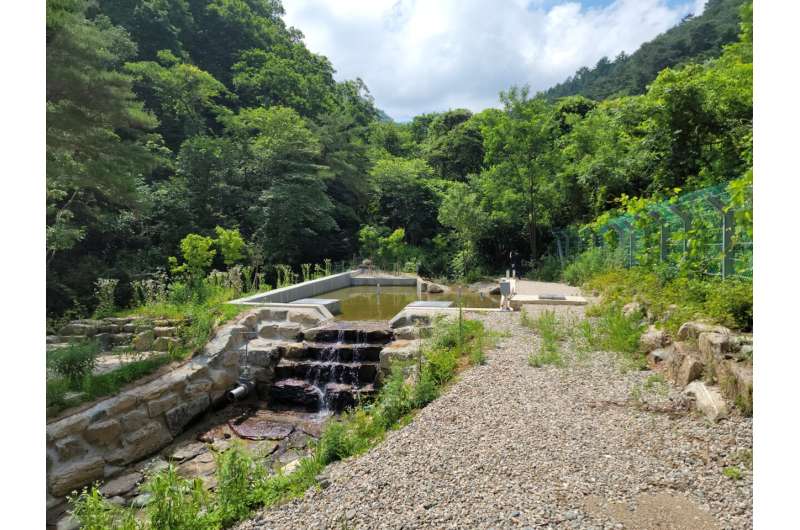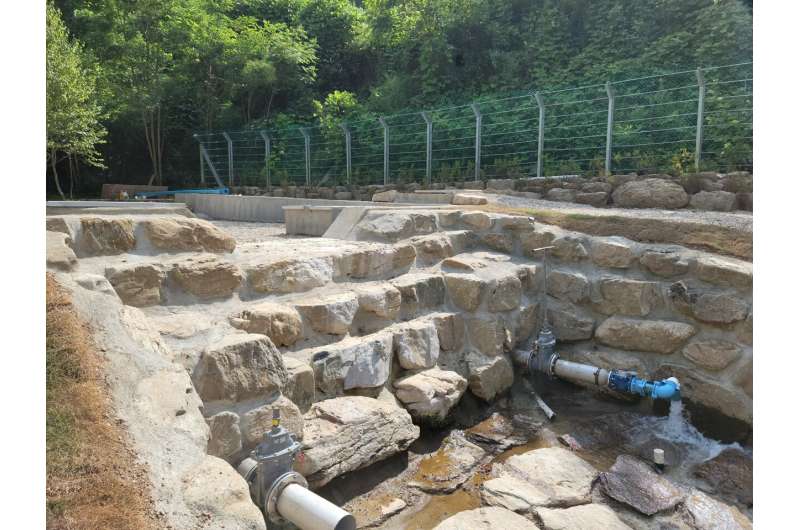An advanced sand dam that can provide water in times of drought

The Korea Institute of Civil Engineering and Building Technology announced the development of Korea’s first sand dam capable of supplying stable water to residents of mountainous highlands during periods of water shortage due to drought. Villagers no longer have to rely on water tank trucks during extreme drought.
The coverage of waterworks for metropolitan and local water supply is nearly 97% in South Korea, but the remains are susceptible to experiencing water shortages during droughts. These regions not connected with waterworks are dependent on small-scale water supply facilities (5,920 facilities) that are sourced from valley water or groundwater. Water tank trucks often had to be mobilized to supply drinking water.
In February 2016, water tank trucks and fire engines had to supply water to the nine villages in Chuncheon City, Korea because the valley water had frozen and the water sources had dried up. Residents in these regions suffer drinking water shortages in severe droughts because of their reliance on small-scale water sources.
The Korean Ministry of Environment established a research group to study ways of utilizing groundwater in response to droughts. The group conducted research on new water supply for the water shortage areas, mainly located along the upstream reaches of rivers, from 2018 to 2022.
Sand dams seem to be an effective solution for the valleys in mountainous areas in Korea. The technology that retains water in sand affords three advantages. Very little water is lost to evaporation; water quality improves as it passes through the sand bed; and the water does not freeze in winter.
A sand dam stores water for later use in dry seasons in such arid regions as Africa where heavy rainfall occurs at rare intervals. During the flood, the dam traps turbid water and lets the sediment particles sink to the bottom for water to be stored in the sand. This primitive technology has been greatly modified and enhanced for drought solution in Korea.
A research team (Dr. Lee, JeongWoo, Dr. Chang, Sun Woo, Dr. Kim, MinGyu) led by Dr. Chung, Il-Moon of the Department of Hydro Science and Engineering Research at KICT built Korea’s first bypass sand dam in Chuncheon City. The team applied the bypass type, a modified version of a sand dam, to avoid any potential unsafe issues when the dam blocks the river that runs fast through the valley.
The modified sand dam indirectly takes groundwater flow retained in the ground, gravel, or sand bed next to the flowing river. The team built the sand dam at the lower part of the small intake reservoir at the side of the main waterway and filled the space behind the dam with sand. A perforated pipeline that carries water passing through the sand bed was laid near the bottom of the sand dam. A new technique of filter pack screen in the pipeline was adopted to prevent clogging problem.
The construction of the sand dam greatly increased the usual flow rate of water to 150 cubic meters per day on average and the water quality was proven to be adequate for drinking. The dam is expected to supply water for at least 10 consecutive days even during a severe drought, which is considered a long-lasting solution to a drought. Management of the bypass sand dam was transferred to Chuncheon City in 2022.

Dr. Chung said, “The sand dam demonstrated that it could ensure consistent water supply even in harsh droughts driven by climate change or freezing of valley water in winter. The technology is expected to greatly improve the quality of life in the local area, and it will likely be used in other regions.”
The findings are published in the journal Water.
More information:
Il-Moon Chung et al, Analysis of Water Supply Capacity of a Sand Dam, Water (2022). DOI: 10.3390/w14193039
Provided by
National Research Council of Science & Technology
Citation:
An advanced sand dam that can provide water in times of drought (2023, April 27)
retrieved 27 April 2023
from https://techxplore.com/news/2023-04-advanced-sand-drought.html
This document is subject to copyright. Apart from any fair dealing for the purpose of private study or research, no
part may be reproduced without the written permission. The content is provided for information purposes only.
For all the latest Technology News Click Here
For the latest news and updates, follow us on Google News.
